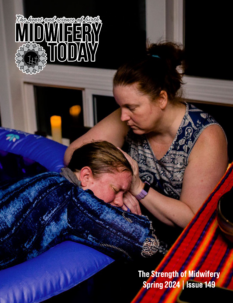
From the United Kingdom
Editor’s note: This article first appeared in Midwifery Today, Issue 61, Spring 2002.
Subscribe to Midwifery Today Magazine
As I prepare this article for the exchange between Midwifery Today and The Practising Midwife, I am conscious of two major reports that have been released here in the U.K. in recent months. As I have been reflecting on them I know their message is pertinent to women and midwives all over the world and it felt appropriate to draw your attention to them. The first was a major audit on Caesarean Section (Thomas & Paranjothy 2001) and the second is the triennial Enquiry into Maternal Death in the U.K. (Lewis 2001).
Caesarean Section
Since the 1970s the trend for caesareans has been consistently rising, also accompanied by a rise in assisted deliveries. Following concerns about this rise in the U.K. and what appeared to be variation in rates between maternity units and regions, the Government Department of Health commissioned the Royal College of Obstetricians and Gynaecologists Clinical Effectiveness Support Unit, in collaboration with the Royal College of Midwives, the Royal College of Anaesthetists and the National Childbirth Trust to investigate why this was happening. They subsequently audited every maternity unit (including private ones) in England, Northern Ireland, Wales and the Channel Islands. Following development of audit standards, data was collected on all births that took place during a three-month period. They evaluated the demographic, clinical and organisational factors associated with variations in caesareans, and assessed the quality of clinical care against the agreed standards. The next phase involved a survey of maternal views and attitudes with exploration of the views of the obstetricians. Interestingly, they didn’t ask for the midwives’ views, though midwives were asked to keep a log of midwifery activities on the labour wards, as were the anaesthetists. A total of 350 local facilitators (many of whom were midwives) were appointed to collect the data. This was a massive undertaking, the first of its kind in the U.K., and the high level of completion is to be applauded. What the statistics showed may be very applicable to the U.S. and to any other developed country in the world.
Overall the main reasons for caesareans are emergencies and repeat caesareans. For the latter figures (67 percent in England) the key to this must be the lowering of the initial caesarean rate. Other key issues are induction (19 percent) and breech presentations (88 percent). The older the woman the more likely she will have a caesarean. The highest rates were in the 40–44 year old group. Fetal compromise and failure to progress in labour were the most common reasons for caesarean. The more overweight a woman is the more likely she is to have caesarean, and she is also more likely to have a thrombosis afterwards. When ethnic groups were identified, African women had the highest caesarean rates and Bangladeshi women had the lowest in this group.
There were large variations in rates between regional Trusts as well as regions. Those who are viewed as the “standard” primips (white, cephalic presentation, first baby, fit and healthy) had much lower caesarean rates, but there remained variation between units (seven percent to 12 percent).
Only three percent of women requested a caesarean and obstetricians agreed to about half of these with no clinical indication. However, seven percent of reasons given were recorded as maternal request.
A total of 162 consultants responded to the questionnaire. Of these, 80 percent agreed that “birth was a natural process that should not be interfered with unless necessary.” Fifty-one percent thought that their unit’s caesarean rate was too high (the median was 23.3 percent), but those consultants who did not think that the rate was too high had a median rate of 19 percent.
Too few midwives are looking after too many women. The standard of 1.5 midwives to one woman, which was achieved 60 percent of the time, was challenged as being set far too low, and that it should be achieved 90 percent of the time. The research also suggested that the target appeared to have been met because of the mechanisms midwives use when the labour wards are busy, i.e., midwives are pulled in from the wards and the community to ensure the labour ward is covered.
Following the results of this audit each unit concerned has been contacted with their local results. The expectation is that they will then examine themselves and their local practises to make changes that will bring down the caesarean rates nationally. The cynical view could be that no differences will be made and the rates will continue to rise. But we shall see. The fact that this audit has been carried out at all is heartening, but it will take time to see if any impact has been made. How do these statistics compare with your unit practise? Are there ways that caesarean rates could be lowered in your locality?
Maternal Death
Once more the report of the triennial Confidential Enquiry into Maternal Deaths (CEMD) in the U.K. (Lewis 2001) is painful reading. Though it covers a very small percentage of the births that take place in our countries, it is apparent that about half of the deaths may have been prevented with better care. We must be aware, too, that for every woman who dies, there are a number of near-misses, the ones who could have been in this report but ended up with morbidity rather than mortality statistics (Waterstone, Bewley, Wolfe 2001). As in previous reports the causes of the highest direct death rates remain consistent: Thrombophlebitis, hypertension and haemorrhage are issues to be very aware of in the women we care for. However, many of these deaths took place before midwifery care generally came into play. In the U.K. the pregnant woman generally goes to her general practitioner, who then tends to refer her on to hospitals and a local midwife for subsequent care. Perhaps we could help matters by ensuring women book for midwifery care as the first point of contact as soon as they are pregnant? Rather than cutting down antenatal visits in those early weeks, midwives could be there, supporting and educating.
There is much that could be questioned on all the issues that were identified. For example, we should question why the rates for deaths from sepsis continue to rise. Only one of these was related to caesarean section, and we need to recognise the insidious nature of these infections. Time and the right treatment are of the essence. This report also identified that those with the greatest social need and deprivation are at highest risk of maternal death, (20 times more likely to die than those in the highest social groups). Domestic violence and poor communication of English are also issues that should not be ignored. What does this mean in practise? That services should be changed to ensure that the marginalized and underprivileged receive the same, if not better, standards of care than those who are well educated and able to shout the loudest. We must listen hard beneath these cries and reach those who are being pushed from pillar to post and take responsibility to shout for them. It means ensuring more cash is available to serve those most in need, providing translators as required and working cross-disciplines to create a welcoming, safe environment for everyone. It means educating staff in effective communication and understanding these communities’ needs. The high proportion of deaths within the travelling community means this group, as well as the Asian and African ethnic groups and the very young, needs specific targeting. These are some of the target areas of Sure Start projects set up in localities in the U.K., and time will tell if these projects are effective in preventing further deaths in the future.
It is most disturbing that this is the first report to identify the potential risk to life of severely depressed women, leading to high rates of violent suicide within the first year after birth. This was the only category where it didn’t matter which social group women were in—the rates for suicide were cross-group. Thus, midwives must be involved in better screening of those potentially at risk for severe depression. There must be more appropriate diagnosis of those with postnatal depression, identification of those with psychotic tendencies and aims to improve care in specific mother and baby units in psychiatric hospitals. It is in those early days of postnatal care where we have so much responsibility. I can’t help feeling that with all the busyness and rushing to the next case that we are missing a great deal, and maybe even exacerbating the problem. Women need time to talk, and we must give them that space. Listen with all that we are, not just our ears. Obviously the way midwives work in the postnatal period in the U.K. is different from other countries, but it is right to be aware of this potential for suicidal tendencies in postnatal women and reflect on ways midwives could help in better preparing women in the antenatal days. There is no doubt that the birth of a first baby can be a major shock to women as they have to adjust to so many new things in their lives. Better preparation by midwives may help to reduce the shock and protect a little from some of the triggers of major depression. Better support services after the birth of the baby may also be a key, but until further research is carried out with psychiatrists we are not going to know what help these desperate women really need. What is important is to recognise the problem and to dialogue about it.
For the majority of these identified deaths we must remember there is a man without a partner and sometimes also without a child; grandparents without a daughter; work places without workers; communities without women. The impact is far-reaching and should not be ignored. What should also be clear is that a large number of these deaths could have been avoided with better care. If we believe something is wrong we have a responsibility to act quickly and get the right people dealing with the emergency, for the sake of the women in our care.
References:
- Lewis, G. (2001). Why Mothers Die: 1997–1999 The 5th report of the Confidential Enquiries into Maternal Deaths in the United Kingdom, RCOG press.
- Sure Start https://www.gov.uk/sure-start-maternity-grant/overview
- Thomas, J., S. Paranjothy. Royal College of Obstetricians and Gynaecologists Clinical Effectiveness Support Unit, The National Sentinel Caesarean Section Audit Report, London: RCOG Press, 2001.
- Waterstone, M., Bewley, S., Wolfe, C., (2001). Incidence and predictors of severe obstetric morbidity: case-control study BMJ 322: 1089–94.
















